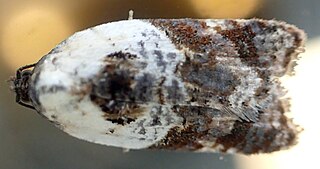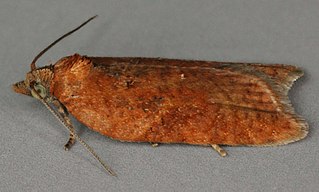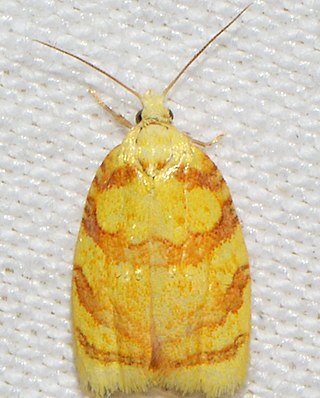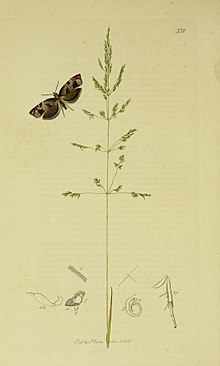
Acleris variegana, the garden rose tortricid moth or fruit tortricid, is a moth of the family Tortricidae. It has a Palearctic distribution. The moth flies from July to September mainly at night and is attracted to bright lights. The larvae feed on various trees and shrubs including rose and apple.

Eurois occulta, the great brocade or great gray dart, is a moth of the family Noctuidae. It is found in northern and central Europe, North Asia and central Asia to the Pacific Ocean and Japan. Also the northern parts of North America. In addition, it is found in Greenland and Iceland. In the south in northern Spain and on the Balkan peninsula.

Acronicta tritona, the Triton dagger moth, is a moth of the family Noctuidae. The species was first described by Jacob Hübner in 1818. It is found in eastern North America, from Nova Scotia west to north-eastern Alberta, south to Florida and Texas, and west to Oregon.
Xestia normaniana, or Norman's dart, is a moth of the family Noctuidae. The species was first described by Augustus Radcliffe Grote in 1874. It is found in North America from Nova Scotia across southern and central Canada to Alberta. In the eastern United States it ranges from Maine to eastern Minnesota, and south along the Appalachians to western North Carolina. It has recently been recorded from Tennessee.
Coenophila opacifrons, the blueberry dart or plain-faced blueberry dart, is a moth of the family Noctuidae. The species was first described by Augustus Radcliffe Grote in 1878. It is found in North America from Labrador and Newfoundland, south to New Jersey, west across the boreal forest to eastern British Columbia, south in the mountains to southern Montana.

Acleris hyemana is a moth of the family Tortricidae. It is found in Europe.

Acleris is a genus of moths belonging to the subfamily Tortricinae of the family Tortricidae. As of 2007, about 241 species were known.

Acleris caledoniana, the Caledonian button, is a species of moth of the family Tortricidae. It is found in Ireland, Great Britain and Poland. It is found in high moorland, where it inhabits mountain bogs.

Acleris fimbriana, the yellow tortrix moth, is a species of moth of the family Tortricidae. It is found in France, Germany, Denmark, Italy, Slovakia, Hungary, Romania, Poland, Norway, Sweden, Finland, the Baltic region, Ukraine and Russia. It is also found in China and South Korea.

Acleris lipsiana is a species of moth of the family Tortricidae. It is found in Great Britain, Spain, France, Belgium, the Netherlands, Germany, Denmark, Austria, Switzerland, Italy, the Czech Republic, Slovakia, Hungary, Poland, Greece, Norway, Sweden, Finland, the Baltic region and Russia. It is also found in North America, where it has been recorded from Alberta and Washington. The habitat consists of high moors and mountainous areas.

Acleris albicomana, the red-edged acleris moth, is a species of moth of the family Tortricidae. It is found in North America, where it has been recorded from Alberta, Arizona, British Columbia, California, Colorado, Florida, Illinois, Indiana, Iowa, Kentucky, Maine, Manitoba, Maryland, Minnesota, Montana, New Mexico, New York, North Carolina, Ohio, Ontario, Oregon, Pennsylvania, Saskatchewan, Tennessee, Virginia and Utah.

Acleris curvalana, the blueberry leaftier moth, is a species of moth of the family Tortricidae. It is found in North America, where it has been recorded from Alabama, Alberta, Arkansas, British Columbia, Florida, Georgia, Indiana, Kentucky, Maine, Manitoba, Maryland, Massachusetts, Michigan, Minnesota, Mississippi, New Brunswick, New Hampshire, New York, Newfoundland, North Carolina, Ohio, Ontario, Pennsylvania, Quebec, Saskatchewan, Tennessee, Virginia, Washington and West Virginia.
Acleris fragariana is a species of moth of the family Tortricidae. It is found in North America, where it has been recorded from Alberta, California, Maine, Minnesota, New Hampshire, New York, Ontario and Washington.

Acleris maculidorsana, the stained-back leafroller moth, is a species of moth of the family Tortricidae. It is found in North America, where it has been recorded from Arkansas, Florida, Georgia, Kentucky, Maine, Maryland, Massachusetts, Michigan, Mississippi, New Jersey, North Carolina, Ohio, Ontario, Pennsylvania, South Carolina, Tennessee, Virginia and Wisconsin.

Acleris bowmanana is a species of moth of the family Tortricidae. It is found in North America, where it has been recorded from Alberta, British Columbia, California, Maine, Manitoba, Maryland, Michigan, New Brunswick, Ontario, Quebec, West Virginia and Wisconsin.
Acleris minuta, the yellow-headed fireworm or lesser apple leaf-folder, is a species of moth of the family Tortricidae. It is found in eastern North America.
Acleris kearfottana is a species of moth of the family Tortricidae. It is found in North America, where it has been recorded from Maine, Ontario, Pennsylvania, Quebec and West Virginia.

Stictea mygindiana is a moth belonging to the family Tortricidae. The species was first described by Michael Denis and Ignaz Schiffermüller in 1775.













